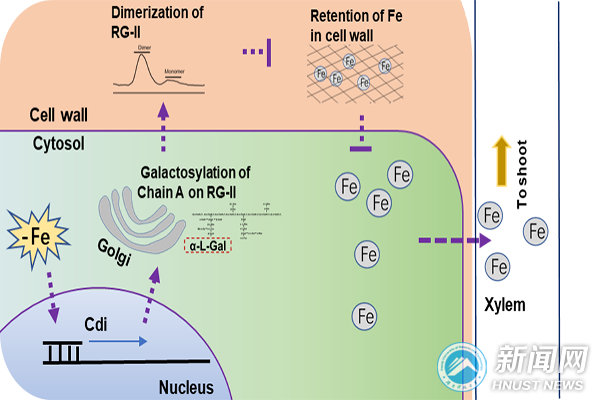On June 23, 2021, a cooperative research article titled “Galactosylation"""""" of Rhamnogalacturonan-II for cell wall pectin biosynthesis is critical for root apoplastic iron reallocation in Arabidopsis”, coauthored by the research teams from the School of Life Science of HNUST and Chinese Academy of Sciences (CAS) was published in the biological top journal Molecular Plant(IF=""""12.084) online. The paper demonstrates the molecular mechanism of a link between cell wall modification and root apoplastic iron (Fe) reallocation in plants.
Since Fe is an indispensable trace mineral element for plants, Fe deprivation not only does harm to their growth, but affects human’s intake of iron through the food chain, hence resulting in various iron-deficiency illnesses. Apoplastic iron in roots (mainly referring to the space outside the cell containing the cell wall) represents an essential Fe storage pool. Moreover, swift and effective utilization of apoplastic Fe is considered to be an important mechanism for plants experiencing Fe deprivation. However, due to the highly complex cell-wall structure, there are few studies about the mechanism of apoplastic iron reallocation. Besides, it is argued that there is even no active modulation in it.

Through years of efforts, the research teams present genetic, biochemical and plant physiological evidence to demonstrate a link between cell wall biosynthesis and apoplastic Fe reallocation and thus indicating the structure of cell wall is vital for efficient usage of cell wall Fe pool.
A working model of apoplastic iron reallocation mediated by Cdi Cdi induced by Fe deficiency catalyzes the transfer of GDP-L-galactose to the terminus of sidechain A on RG-II in Golgi. Galactosylation of RG-II is required for RG-II dimerization and cell wall modification, which then promotes Fe release from cell wall and the subsequent uptake into symplast and loading into long-distance transport path.
Dr. Peng Jiashi, from the research group of the School of Life Science of HNUST, is the co-first author of this paper (ranking No.1), and HNUST is one of the cooperative research units. This work is funded by the National Natural Science Foundation of China (NFSC)(31700212、(31325003 and 31530051)and other programs.
(Translated by WANG Yan)